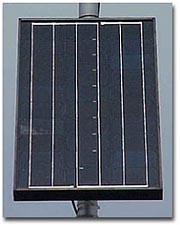
This is the first of two articles that will focus on solar pumping. We start with a review of solar energy, followed by a description of the various methods of converting solar energy.
Solar energy is one of the free benefits that come with residence on planet Earth. There is enough solar energy falling on the surface of the earth to meet our energy needs forever. You and I have enough solar energy falling on our rooftops - provided they are not in the shade of a large maple tree - to heat and cool our homes, and to provide our electricity. The problem is in converting this energy into a form we can use - heat or electricity.
The technology now exists to convert solar energy into a form of energy we can use around our homes, but, in most cases, the conversion cost is not cost effective. The cost of conventional energy - i.e. natural gas, heating oil, propane and electricity - is so low, the payback on the solar equipment is too long to be generally acceptable. With the recent jump in energy costs, however, solar is looking more financially feasible every day.
One notable exception is solar swimming pool heating, which is economically viable right now in most sunny areas. And, if you live in a relatively sunny local, you can put a solar hot water heater on your home for a few thousand dollars, which will pay for itself in less than five years if your conventional energy source is electricity or propane, and in less than seven years if you heat water with natural gas. Unfortunately, most of us won't spend the money needed with that long a payback.
Back in the early ´80s, the federal government offered tax credit incentives to encourage us to install solar systems on our homes, and many Americans took advantage of this program and already are enjoying the benefits of solar. Today, many states offer incentives to encourage the installation of solar equipment, but, until the cost of conventional fuels reaches a point where the cost to purchase and maintain a solar-powered system is lower than the cost to purchase the energy it replaces, solar energy equipment will be relegated to the hinterlands and/or to the rooftops of visionaries.
The Availability of Solar Energy
There are approximately 300 Btus per square foot per hour of solar energy falling on the surface of the earth in the United States on a sunny day. Btu stands for British thermal unit, and one Btu is the amount of energy needed to raise the temperature of 1 pound of water 1 degree Fahrenheit. To heat the water for residential use, approximately 80 square feet of solar panel area typically is required.
When working with electricity, the term watt is commonly used. One Btu per square foot per hour equals 3.16 watts per square meter.

Solar Thermal Panels
Converting solar energy to heat energy is fairly simple and efficient. All you need is a black surface to collect the solar energy and convert it to heat energy, as well as some way of carrying away the heat energy. The most common method is to attach copper pipes to a copper sheet, paint or coat the sheet black, mount it in an insulated glass covered box, run water through the pipes, and presto, you have a solar water-heating collector (see Figure 1). Such a device will convert solar energy at a rate of 80 percent to 90 percent efficiency, depending on the types of black coating, glass and enclosure used.
Converting solar energy to electricity is not as simple or efficient. One method is to use a solar thermal panel as described above, add mirrors to concentrate the energy so temperatures above the boiling point of water can be achieved, and run a steam generator, just as you would for generating electricity with gas, coal or nuclear energy. This technique is used in a number of solar electric-generating plants in the southwestern United States and around the world, but it is impractical for small-scale residential solar/electric conversion.

Photovoltaic Panels
The more common method of converting solar energy to electricity in residential applications is to use a photovoltaic (PV) panel, which provides direct conversion of solar energy to electricity (see Figure 2). PV panels consist of a number of PV cells, usually silicone, which are wired together and housed in a weatherproof panel. PV panels vary in size from a few square inches to many square feet. The exact size needed for pumping applications takes a number of factors into consideration and will be discussed in detail next month.
Also next month, we will look at the various types of solar pumps available, describe the advantages and disadvantages of each, and list sources of supply for equipment and sources for information. ´Til then ….
ND

Report Abusive Comment